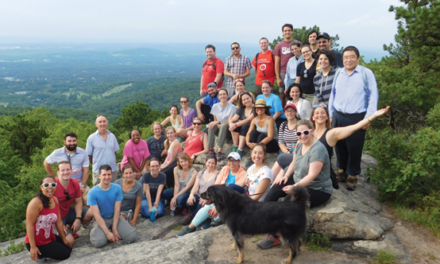
Schools that achieve strong results with black students address race directly and teach in ways that empower students to learn.
To promote equality, many educators try to be “colorblind.” They try to look past the race of their students to avoid bias and create a refuge from the racially charged atmosphere outside the classroom.
Although the impulse is understandable and the sentiment is admirable, the colorblind approach is misguided. We cannot avoid being affected by racial currents in society, whether we acknowledge them or not. We all aspire to a world in which race is not used to prejudge people. However, by confusing the pluralistic and embracing world we strive for with the racially divisive world we have, we decrease the likelihood of ever attaining our goal. Likewise, many educators espouse the mantra “all students can learn,” but they tend to avoid hard conversations about strategies that will help particular students learn.
Four focuses that work
Programs aimed at meeting the needs of “all students” — for example whole-school reform and school-accountability initiatives — don’t necessarily address the needs of black youth challenged by poverty. Typically, black students still perform at significantly lower levels than white and Asian students. Schools that do achieve strong results for black students address racial dynamics carefully yet directly, empower students to bring their whole selves to school, and teach in ways that leverage students’ experiences and cultures. In particular, these schools do four things to ensure success with black students:
- They direct attention, strategies, and resources to black student achievement.
- They provide opportunities for adult learning about race, culture, class, and power and about how those dynamics make certain communities vulnerable.
- They foster strong relationships between educators and black students.
- They create classroom environments that emphasize excellence and empower students to exercise agency over their own learning.
A focus on achievement
Educators who see transformational results with black youth embrace students’ race and culture as central to their identity and as assets to build on. One excellent example of this approach is being implemented in Oakland, Calif. The school district’s African American Male Achievement (AAMA) initiative, which began in 2010, encourages students to find strength in their community and themselves.
The core of the initiative is the Manhood Development Program (MDP), an elective course taught by black men at 17 schools throughout the district. About 450 students in grades 3-12 enroll in the course each year. The MDP focuses on the contributions of Africans and African-Americans from ancient times up through the present. In addition, the AAMA initiative runs a career academy in entrepreneurship, social innovation, and civic engagement; a student leadership council; a peer mentoring program; and assemblies featuring role models from the community.
The initiative increases students’ belief in themselves and helps teachers see the potential in these young men. The results have been positive. For example, the graduation rate of black boys in the district rose from 47% in 2011 to 53% in 2014. Similarly, suspensions of black boys decreased by one-third between 2012 and 2013. Finally, participants have raised their grades. On average, boys in the program increased their grade point average to 2.12 in 2014, substantially higher than the 1.7 grade point average among black boys not participating in the program. Since observing this progress among African-American males, Oakland has expanded the initiative to cover other vulnerable populations. In addition, districts in other parts of the country, such as Minneapolis and the District of Columbia, have launched similar programs.
One of the lessons we can draw from the success of the initiative is that having multiple indicators of student performance — such as graduation rates, suspension rates, and grade point averages — helps educators see the whole child and address each student’s needs. In addition, the program has been successful because it helps schools reconnect with their mission and consider how to realize those aspirations for black students specifically.
A focus on adult learning
Teachers of all races can successfully serve black students — and professional development can accelerate the process. School leaders play an important role by providing time and support for professional learning, modeling an assets-based approach toward students and staff, and demonstrating profound respect for students and families.
Schools that effectively teach black students devote professional learning time to topics such as implicit bias, the school experience of black youth throughout history, and culturally responsive instruction. Successful school teams encourage self-reflection — for example, by helping educators understand their experiences with racial issues and how they’re sometimes complicit in replicating the status quo.
This self-analysis is particularly important because most black students are taught by teachers of a different race. In 2014, more than 50% of U.S. public school students were students of color, but more than 80% of the teaching force was white (Hrabowski & Sanders, 2015). This mismatch in ethnicity is a problem because white teachers tend to have lower expectations for black students than black teachers have for the same students. For example, in a recent study published by the Upjohn Institute, when asked about any specific black 10th grader, white teachers were about 30% less likely than black teachers to predict that the student would someday earn a college degree (Gershenson, Holt, & Papageorge, 2015). Expectations can affect how teachers treat students, which can affect how well students perform (Rosenthal & Jacobson, 1968).
Schools that successfully address issues of race tend to discuss those issues explicitly, and they begin by establishing group norms for discussions. For example, agreeing as a staff to abide by the Four Agreements of Courageous Conversations (Singleton & Linton, 2006) can foster productive conversations about race. The agreements advise participants to:
- Stay engaged.
- Expect to experience discomfort in any discussion about race.
- Speak their truth.
- Expect and accept a lack of closure; participants need to “hang out in uncertainty” and not rush to quick solutions.
In addition to establishing norms, successful schools use discussion protocols to foster staff members’ active participation and exploration of their own experiences, identities, and biases. Examples of effective discussion protocols include The Paseo (www.nsrfharmony.org/system/files/protocols/paseo.pdf) and The Constructivist Listening Dyad (www.nsrfharmony.org/system/files/protocols/dyad.pdf). The Paseo is a two-step process involving individual reflection and conversations about identity with members of a group. In Dyads, members of a pair take turns speaking about a sensitive topic without interruption or commentary from the other.
Even if school teams follow norms and protocols, conversations about race can still be difficult. The discussions might feel less productive than, say, collaboratively designing lessons on geometry, photosynthesis, or textual analysis. However, facing our shared past and our collective responsibility for crafting a better future requires us to understand race, culture, class, and power.
A focus on relationships
Effective schools don’t see promoting black student achievement as a purely technical activity. These schools don’t search for a silver bullet instructional strategy, but, instead, understand that trustful relationships are essential to creating a thriving academic community. In Culturally Responsive Teaching and the Brain (2015), Zaretta Hammond labels the ideal teacher-student relationship a learning partnership. Such a partnership consists of two key components — rapport and alliance. Rapport refers to the degree to which teachers have established trust by affirming and validating student experiences. Alliance refers to a sense of shared mission between teacher and student in achieving a set of agreed-upon goals.
Before diving into academic content with students and using the same teaching styles that have produced the current student outcomes, educators need to get to know black students and their families — their interests, goals, and past school experiences. Successful strategies for doing this include home visits, student surveys and focus groups, conversations between teacher and student, and revamped parent-teacher conferences that create more opportunity for parent and student voice. Pedro Noguera (2007) articulates the value of tapping the wisdom of students and their families in this way: “Solutions to some of the problems facing our nation’s high schools may not be as out of reach as they have seemed, particularly if we have the wisdom and courage to listen to those who bear the brunt of our schools’ failures” (p. 206).
Teachers also can select three to five black members of their class as “focal students” who will act as a lens on the effectiveness of their instruction. Under this strategy, teachers spend time learning about these students (using the methods mentioned above) and then design instruction that reflects students’ interests and culture. The instruction then becomes much more engaging and, therefore, more likely to foster deep learning.
A useful approach to designing culturally relevant instruction is to think of classroom materials and topics as “mirrors,” “windows,” and “bridges” (Purnell et al., 2007). Mirrors reflect students’ backgrounds; windows expose students to other cultures; and bridges provide opportunities for students to connect their own cultures and experiences to those of others. When it comes to culturally responsive instruction, Hammond (2015) reminds us not to focus on relatively superficial items such as food, dress, and music but instead on “deep culture” — e.g., how kinship is defined and notions of fairness. Selecting appropriate “mirrors” to use with black students is possible when teachers have come to know their students and what resonates with them.
A focus on excellence
The education community is increasingly focused on social-emotional learning, noncognitive skills, a growth mindset, and student agency. These aspects of education are important for all students; however, research shows that if done right, these approaches can particularly benefit students of color (Farrington et al., 2012). Schools that are having success in these areas don’t dwell on what they believe students should bring to the classroom (“if only he had more grit!”), but, instead, they understand that the classroom environment plays a prominent role in either boosting or dampening students’ sense of agency over their learning (Ferguson et al., 2015). In particular, schools that are effective with black students create a culture that reinforces the following student mindsets:
- Belonging: “I belong in this academic community.”
- Value: “This work has value to me.”
- Growth mindset: “With effort, my skills can grow.”
- Self-efficacy: “I can do this.”
These mindsets tend to be less systematically reinforced for black students than for their white peers. Schools that truly meet the needs of black students work to shift their environment and practices to empower black students, and they have specific strategies for helping students strengthen these mindsets. For example, a key to building self-efficacy is receiving thoughtful feedback on academic performance. However, teachers who are worried about being perceived as biased may overcompensate by excessively praising students, particularly students of color. As a result, students of color may end up receiving significantly less critical feedback on how to improve their work. Unfortunately, this overpraising doesn’t increase students’ sense of efficacy and can lead to disengagement (Cohen & Steele, 2002). Educators can counter this tendency by adopting a “warm-demander” style of instruction, communicating personal regard for students while demanding academic excellence. This message of “I’m going to push you to excel because I believe in you” is particularly important for building the efficacy of black students, and it’s especially powerful when all staff members in a school communicate it.
In addition, black students need to feel that what they’re learning in school has value to them. Most teachers try to communicate the value of learning to students, but the message is often “you need to pay attention because this is important.” Schools that are successful for black students flip this communication and trust students to determine the value of what they’re learning. Rather than working to convince, they empower.
For example, teachers give students time to reflect on and write about what’s important to them and what principles guide their lives. These exercises have been shown to have dramatic effects on student achievement, particularly for black students and students performing significantly below grade level. In several studies in suburban middle schools, African-American and Latino students were asked during stressful moments to write about things most important to them — their relationships with friends or family or their personal interests. When students who often feel like outsiders reflect on what affirms them, they become more confident learners, which increases their academic performance. The intervention reduced the racial achievement gap by nearly 30%. African-American students who were randomly selected for the writing exercise had significantly higher grade-point averages over two years than those who were not (Stanford Graduate School of Business, 2012).
Schools that meet the needs of black students also offer opportunities for students to make choices about their learning — for example, letting students decide which topics to research, the order in which they will complete activities, and the method of demonstrating content mastery. This lets students create their own sense of value around what they’re learning. Moreover, effective educators enlist black youth to help create a school culture in which students actively support one another. This culture includes opportunities for students to develop norms and procedures, provide feedback to peers, and share and discuss their values.
Success is within reach
Many excellent public schools are demonstrating that success with black students is well within reach. Effective schools have developed a multipronged approach that increases their chances of success. These schools begin by truly seeing black students and focusing on their needs. Taking that step enables school teams to have the conversations, do the learning, build the relationships, and create the empowering environments that allow black students to thrive.
This work doesn’t always go smoothly. Some strategies work well in some contexts but not in others. Schools must be willing to try techniques that feel awkward or even miss the mark completely. As with all pedagogical practices, the chances of success increase if educators are transparent with students about what they’re trying to accomplish and if they enlist students in the effort. Learning flourishes when educators and black students truly see each other.
References
Cohen, G.L. & Steele, C.M. (2002). A barrier of mistrust: How stereotypes affect cross-race mentoring. In J. Aronson (Ed.), Improving academic achievement: Impact of psychological factors on education (pp. 303-327). San Diego, CA: Academic Press.
Farrington, C.A., Roderick, M., Allensworth, E., Nagaoka, J., Seneca Keyes, T., Johnson, D.W., & Beechum, N.O. (2012). Teaching adolescents to become learners: The role of noncognitive factors in shaping school performance — a critical literature review. Chicago, IL: Consortium on Chicago School Research.
Ferguson, R.F., Phillips, S.F., Rowley, J.F.S., & Friedlander, J.W. (2015). The influence of teaching beyond standardized test scores, engagement, mindsets, and agency. Cambridge, MA: Harvard University, Achievement Gap Initiative.
Gershenson, S., Holt, S.B., & Papageorge, N.W. (2015). Who believes in me? The effect of student-teacher demographic match on teacher expectations. Upjohn Institute Working Paper, 15-231. http://dx.doi.org/10.17848/wp15-231.
Hammond, Z. (2015). Culturally responsive teaching and the brain. Thousand Oaks, CA: SAGE.
Hrabowski, F.A. & Sanders, M.G. (2015, Winter). Increasing racial diversity in the teacher workforce: One university’s approach. NEA Higher Education Journal, 101-116.
Noguera, P.A. (2007). How listening to students can help schools to improve. Theory Into Practice, 46 (3), 205-211.
Purnell, P., Ali, P., Begum, N. & Cartner, M. (2007). Windows, bridges, and mirrors: Building culturally responsive early childhood classrooms through the integration of literacy and the arts. Early Childhood Education Journal, 34 (6), 419-424.
Rosenthal, R. & Jacobson, L. (1968). Pygmalion in the classroom: Teacher expectation and pupils’ intellectual development. New York, NY: Holt, Rinehart, & Winston.
Singleton, G.E. & Linton, C. (2006). Courageous conversations about race: A field guide for achieving equity in schools. Thousand Oaks, CA: Corwin.
Stanford Graduate School of Business. (2012). The value of “values affirmation.” Insights. www.gsb.stanford.edu/insights/value-values-affirmation
Originally published in February 2017 Phi Delta Kappan 98 (5), 24-29. © 2017 Phi Delta Kappa International. All rights reserved.
ABOUT THE AUTHORS

Brian Edwards
BRIAN EDWARDS is research writer at Partners in School Innovation, San Francisco, Calif.

Derek Mitchell
DEREK MITCHELL is chief executive officer at Partners in School Innovation, San Francisco, Calif.

Jesse Hinueber
JESSE HINUEBER is senior director of program support at Partners in School Innovation, San Francisco, Calif.










